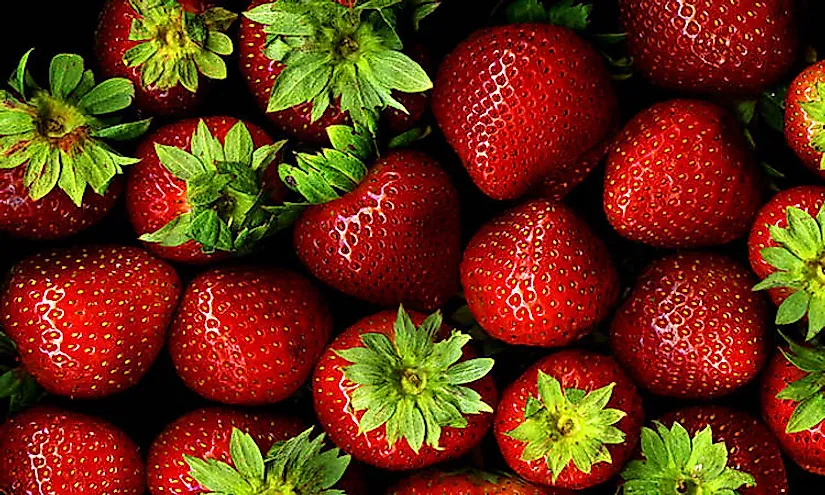Countries That Produce the Most Strawberries

Strawberries, A Popular Fruit In Many Parts Of The World
Strawberries (Fragaria ananassa) are a widely grown hybrid of the Fragaria genus. Strawberries are globally cultivated for their fruits which are popular for their distinctive succulent nature, bright red color, juicy texture, and aroma. Strawberries are widely consumed either fresh or used in the preparation of juices, ice-creams, pies, milkshakes or chocolate. Garden strawberries were first propagated during the 1970's in Brittany, France through crossbreeding Fragaria virginiana from the eastern regions of North America and Fragaria chiloensis from Chile which was brought in 1714. However, cultivars of Fragaria ananassa have dominated the commercial production of strawberries. Strawberries are aggregate accessory fruits which mean their fleshy parts are derived from the receptacle that holds the plants’ ovaries and not the ovaries themselves. Strawberries contain seeds on the outer membrane of the fruit.
The Uses And Benefits Of Strawberries
Other than being consumed as fresh fruits, strawberries are dried then used in the production and preparation of foods such as cereal bars, frozen, or they can be preserved. Strawberry flavorings and strawberries are used as a common addition to dairy products such as yogurts, milkshakes, flavored milk, ice cream, and smoothies. Strawberries are used to make a popular dessert known as strawberries and cream which is famously consumed during the Wimbledon tennis tournament in Britain. Extracts derived from the Strawberry pigment can be used to make natural acid and base indicators. Human-made strawberry flavorings are used in the manufacturing of many products such as lip gloss, perfumes, cosmetics, candy, and hand sanitizers among others. Strawberries are packed with antioxidants that are essential in decreasing cardiovascular disease, maintaining blood sugar levels, eye care, proper brain function, and decreased risk of obesity among others. The phytochemicals found in strawberries are a significant source of anti-inflammatory and anticancer properties. Studies link the consumption of strawberries to lower rates of hypertension, cancer, and inflammation. Besides, the nutritional and health benefits, production of strawberries have significant economic benefits to its top producing countries.
Cultivation Of Strawberries
Strawberry cultivars differ in many characteristics including color, degree of fertility, liability to disease, flavor, season of ripening, constitution of the plant, size, and shape. An average strawberry consists of about 200 seeds on its outer membrane. Some strawberry plants vary in the maturation of their sexual organs while others vary in foliage. Most strawberry flowers tend to appear hermaphroditic like in anatomy but can perform as either male or female. For the commercial production of strawberries, the plants are grown from runners and then generally allotted as either plugs or desolate root plants. The cultivation of strawberries can follow either the annual plasticulture model or the perennial system of mounds of matted rows. Planting of strawberries are often grouped according to their flowering habits and can also be cultivated indoors in strawberry pots.
Production And Top Producing Countries In The World
The United States is the world leading producer of strawberries accounting for 1,312,960 tons in 2011, followed by Turkey with 302,416 tons and Spain in third place with 262,730 tons. Other top strawberry producing countries in the world include Egypt, Mexico, Russia, Japan, South Korea, Poland, and Germany.
Which Countries Are The Leading Producers Of Strawberries In The World?
| Rank | Country | Production (in tons) |
|---|---|---|
| 1 | USA | 1,312,960 |
| 2 | Turkey | 302,416 |
| 3 | Spain | 262,730 |
| 4 | Egypt | 240,284 |
| 5 | Mexico | 228,900 |
| 6 | Russia | 184,000 |
| 7 | Japan | 177,300 |
| 8 | South Korea | 171,519 |
| 9 | Poland | 166,159 |
| 10 | Germany | 154,418 |











